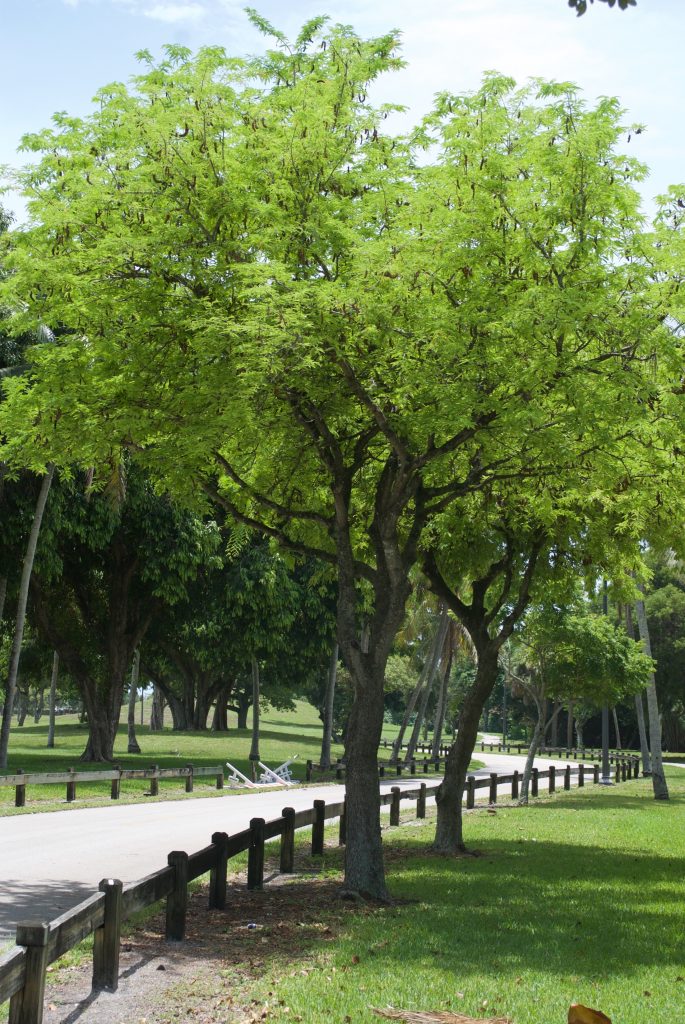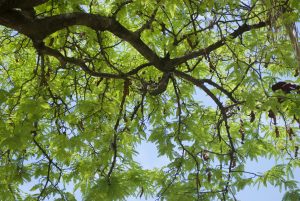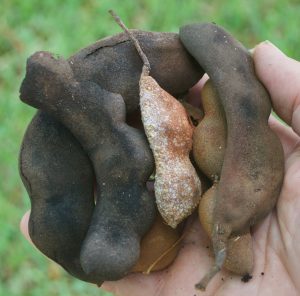
A pair of fruiting Tamarind Trees. Photo by Green Deane
I drove past a dozen Tamarind trees for a decade or so until I looked up one day. The lumpy brown pods on pretty trees had finally caught my attention.

The pods stay on the tree a long time. Photo by Green Deane
As most folks know Tamarind is used as a flavoring though you can crack open ripe fresh pods and eat the pulp inside. I have not only picked them up off the ground — what’s a few bugs and bacteria? — but also climbed trees for them. The sweet and tart flavor that liven pallets everywhere is also nutritious. As you might expect that sweetness comes with an energy price: 239 calories per 100 grams. What most folks don’t realize is that Tamarind leaves are also edible raw or cooked.
Once one notices it is easy to see the Tamarind (Tamarindus indica tam-ah-RIN-dus inn-DIC-ah) is in the greater pea family (and most of them not edible.) The Tamarind is native to Africa and is also monotypic, that is, it is the only tree in its genus. Some genus have hundreds of trees, the Tamarinindus has only one (the Ginkgo tree is also monotypic with only it in its genus.) Slow growing to 100 feet the Tamarind is a massive tree you plant for the next several generations.

Tamarind Pods naturally dehydrate. Photo by Green Deane
A mature tree can produce 500 pounds of pods a year. The pods themselves are collected when they’re cinnamon brown. The wood is yellow with red streaks and termite resistant. As for the name it is part right and part wrong. Tamarind is said to come from the Arabic “tamar hindi” meaning Indian date. It was so associated with India the species was called indica which means from India. The botanist bungled it again and should have called it Tamarindus africana or the like.
And where are those dozen Tamarind trees? They encircle the first traffic circle at the north entrance of Dreher Park in West Palm Beach… Mr. Dreher knew what he was doing.
Green Deane’s “Itemized” Plant Profile
IDENTIFICATION: Graceful strong tree with dropping feathery foilage of pinnate leaves three to six inches long, evergreen, dark gray rough bark, flowers small pink racemes. Lumpy four-inch long seed pods turning brown as they ripen.
TIME OF YEAR: As a tropical species it reported flowers in summer, green fruit appear around December or January and ripen April to May. But, I have picked ripe fruit September to November.
ENVIRONMENT: Tolerates most soil as long as well-drained and not crowded by other trees. While it is in the pea family it does not fix nitrogen.
METHOD OF PREPARATION: Young pods are used for seasoning, they can be roasted, peeled and eaten. Older velvety pods are eaten out of hand. Pulp from the dehydrate fruit — which they do naturally — is used in a wide variety of ways such as made into sauces curries, chutneys and bitters. It is also used to make candy. Flowers and young leaves are edible as are boiled or roasted seeds. You can also soak the pods, once soft remove the seeds, then dehydrate the rest. It will last for a year in the refrigerator.

